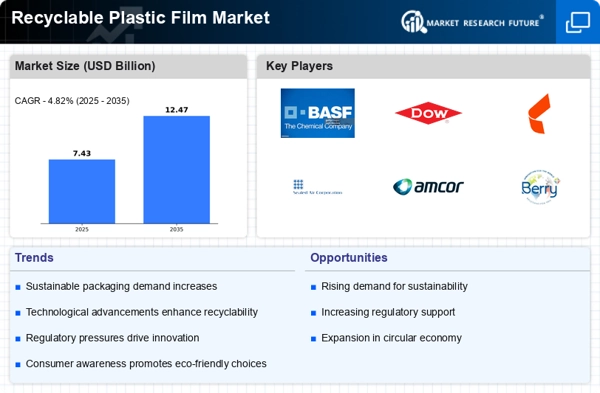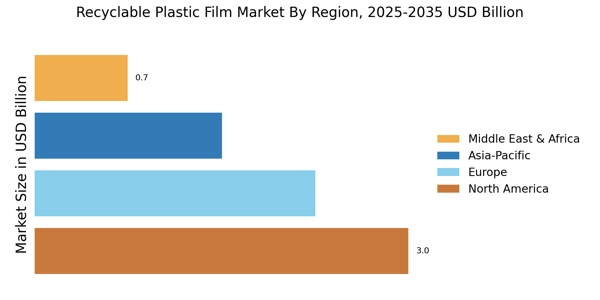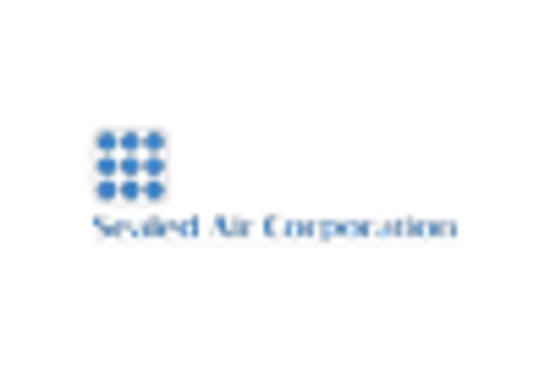Collaboration Across the Supply Chain
Collaboration across the supply chain is emerging as a crucial factor in the growth of the Recyclable Plastic Film Market. Stakeholders, including manufacturers, retailers, and recyclers, are increasingly recognizing the importance of working together to enhance recycling rates and improve the overall sustainability of plastic films. Initiatives that promote circular economy practices are gaining traction, as they facilitate the sharing of resources and knowledge among supply chain partners. For instance, partnerships between brands and recycling facilities can lead to the development of closed-loop systems, where recyclable plastic films are collected, processed, and reused. This collaborative approach not only enhances the efficiency of recycling efforts but also strengthens the Recyclable Plastic Film Market by creating a more sustainable ecosystem.
Regulatory Support for Recycling Initiatives
Regulatory support for recycling initiatives is becoming increasingly influential in shaping the Recyclable Plastic Film Market. Governments worldwide are implementing stringent regulations aimed at reducing plastic waste and promoting recycling. For example, several countries have introduced mandates requiring a certain percentage of recycled content in packaging materials. This regulatory landscape encourages manufacturers to invest in recyclable plastic films, as compliance with these regulations is essential for market access. Furthermore, financial incentives and grants for recycling programs are being offered, which can bolster the growth of the Recyclable Plastic Film Market. As regulations continue to evolve, the demand for recyclable solutions is expected to rise, further propelling market growth.
Consumer Preference for Eco-Friendly Products
Consumer preference for eco-friendly products is a significant driver of the Recyclable Plastic Film Market. As environmental consciousness rises, consumers are increasingly opting for products that demonstrate sustainability. This shift in consumer behavior is compelling manufacturers to explore recyclable plastic films as a viable alternative to conventional packaging materials. Market Research Future indicates that approximately 70% of consumers are willing to pay a premium for sustainable products, which underscores the potential profitability of investing in recyclable solutions. Consequently, businesses that prioritize eco-friendly packaging are likely to gain a competitive edge in the Recyclable Plastic Film Market, as they align their offerings with consumer values and preferences.
Technological Advancements in Recycling Processes
Technological advancements in recycling processes are playing a pivotal role in enhancing the efficiency and effectiveness of the Recyclable Plastic Film Market. Innovations such as advanced sorting technologies and chemical recycling methods are enabling the recovery of high-quality materials from plastic waste. For instance, recent developments in enzymatic recycling have shown promise in breaking down complex plastic structures, making it easier to recycle films that were previously deemed non-recyclable. This evolution in recycling technology not only increases the volume of recyclable plastic films but also improves the overall quality of recycled materials, thereby attracting more manufacturers to adopt these solutions. As a result, the Recyclable Plastic Film Market is likely to experience significant growth driven by these technological advancements.
Growing Demand for Sustainable Packaging Solutions
The increasing consumer awareness regarding environmental issues has led to a growing demand for sustainable packaging solutions. This trend is particularly evident in the Recyclable Plastic Film Market, where companies are actively seeking alternatives to traditional plastic films. According to recent data, the market for sustainable packaging is projected to reach USD 500 billion by 2027, indicating a robust growth trajectory. As consumers prioritize eco-friendly products, manufacturers are compelled to innovate and adopt recyclable plastic films, which not only reduce waste but also align with corporate sustainability goals. This shift towards sustainable packaging is likely to drive the Recyclable Plastic Film Market, as businesses strive to meet consumer expectations and regulatory requirements.


















Leave a Comment